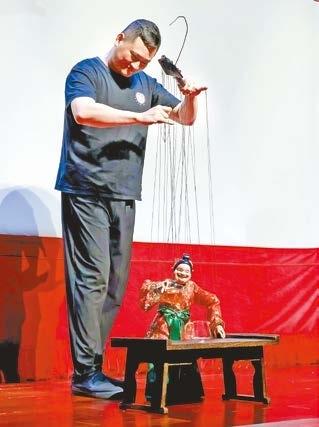

Debra Li debra_lidan@163.com THE international conference hall of Shenzhen University’s Yuehai campus was fully packed Tuesday evening, as curious students and teachers attended a live show performed by 13 members of Lufeng’s shadow puppet troupe from southeast Guangdong Province. A highlight of a two-day project initiated by SZU’s School of Media and Communication, the show, which lasted a little more than an hour, left the audience marveling at the mesmerizing charm of this ancient folk art. The project, a spinoff from a summer vacation field trip organized by the school, aims to promote traditional Chinese culture and build a connection between Shenzhen and the rural regions of Lufeng. The troupe performed six short plays as well as excerpts from a full-length show, which recounted the story of a woman soldier named Lai Yuechan from the Lufeng region, who bravely fought against the tyranny of the warlords during the turbulence of the early 20th century. The only remaining puppetry tradition in South China, Lufeng puppetry originated in the late Song Dynasty (960-1279), brought by migrants from the nearby Fujian Province. Thriving in the Ming (1368-1644) and Qing (1644-1911) dynasties, the art combines painting, sculpture, music, and theatrical performance. Each measuring about 60 cm tall, these puppets, made of cowhides, have vivid facial features as well as limbs and bodies in the right proportion to real humans. Not only can they move at joints, but the puppets can also open and close their mouths and eyes. Primarily based on Zhengzi opera, its music has influences from Lufeng fishermen’s tunes and local folk music. In May 2006, Lufeng puppetry was approved as the first batch of State-level intangible cultural heritages. Then, in November 2011, the folk art was again inducted by UNESCO as a world intangible cultural heritage. Over the years, the Lufeng troupe has won multiple awards at national puppet show competitions. Apart from the show, a mini-exhibition on the outdoor plaza in front of the Zhiyi Building on campus also attracted a large following. The exhibition featured 12 cultural heritages from the Lufeng region and 17 inheritors of those traditions, including a rolling dragon dance, a traditional pot-making technique, papercutting, metal sculpture, woodcarving, and Yingge dance, among others. “I was very impressed by the meticulous steps involved in hand-making these crafts and the perseverance of the inheritors in honing their skills,” said Chen Xinyi, a student attending the exhibition. “For instance, it takes more than 10 steps to craft the teethed pot, a commonplace utensil used in the Lufeng area.” The two-day project also highlighted a workshop yesterday morning, where 80 students learned the basics of making shadow puppets. Chen Peiyang, a veteran member of the Lufeng troupe, and Zheng Xiaodan, whose handmade shadow puppets were collected by the China Intangible Cultural Heritage Center, served as tutors. The project is also an answer to Guangdong provincial authorities’ call to boost the economy of less-developed regions of Guangdong, according to Zhou Xiaoqian, Party chief of SZU’s Media and Communication School. “We will focus on empowering the preservation and spread of traditional Chinese culture with digital technology in the future,” she added. SZU’s Media and Communication School has always focused on preserving and promoting traditional Chinese culture. The school has organized campus fairs featuring cultural heritages as well as a course teaching kintsugi, an ancient Chinese ceramic restoration technique. | 
